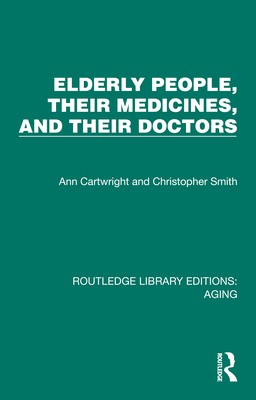
- We will send in 10–14 business days.
- Author: Ann Cartwright
- Publisher: Routledge
- ISBN-10: 1032691379
- ISBN-13: 9781032691374
- Format: 14 x 21.6 x 1.3 cm, hardcover
- Language: English
- SAVE -10% with code: EXTRA
Elderly People, Their Medicines, and Their Doctors (e-book) (used book) | bookbook.eu
Reviews
Description
In the late 1980s, an increasing proportion of all prescribed medicines went to people over 65 years of age, not only because they constituted a growing sector of the population but also because their consumption rate, unlike that of younger people was increasing. This increase was therefore a matter for widespread concern which had until now been largely speculative, as no recent national survey had focused on this issue.
Originally published in 1988, Ann Cartwright and Christopher Smith looked at the medicines prescribed for, and taken by, a nationally representative sample of elderly people. The experiences and views of both patients (elderly people) and professionals (general practitioners) are examined and related. What is revealed is how much, and how little GPs knew about the social circumstances and medicine taking of their elderly patients. Evaluation of all the prescribed medicines taken shows the extent of elderly people's knowledge of their medication and identifies duplications, potentially harmful interactions, contraindications, and inappropriate dosages. Recommendations for action to be taken by doctors, pharmacists, medical educators, and elderly people themselves made this book essential reading for all those concerned with the health and welfare of elderly people at the time.
EXTRA 10 % discount with code: EXTRA
The promotion ends in 17d.16:43:33
The discount code is valid when purchasing from 10 €. Discounts do not stack.
- Author: Ann Cartwright
- Publisher: Routledge
- ISBN-10: 1032691379
- ISBN-13: 9781032691374
- Format: 14 x 21.6 x 1.3 cm, hardcover
- Language: English English
In the late 1980s, an increasing proportion of all prescribed medicines went to people over 65 years of age, not only because they constituted a growing sector of the population but also because their consumption rate, unlike that of younger people was increasing. This increase was therefore a matter for widespread concern which had until now been largely speculative, as no recent national survey had focused on this issue.
Originally published in 1988, Ann Cartwright and Christopher Smith looked at the medicines prescribed for, and taken by, a nationally representative sample of elderly people. The experiences and views of both patients (elderly people) and professionals (general practitioners) are examined and related. What is revealed is how much, and how little GPs knew about the social circumstances and medicine taking of their elderly patients. Evaluation of all the prescribed medicines taken shows the extent of elderly people's knowledge of their medication and identifies duplications, potentially harmful interactions, contraindications, and inappropriate dosages. Recommendations for action to be taken by doctors, pharmacists, medical educators, and elderly people themselves made this book essential reading for all those concerned with the health and welfare of elderly people at the time.


Reviews